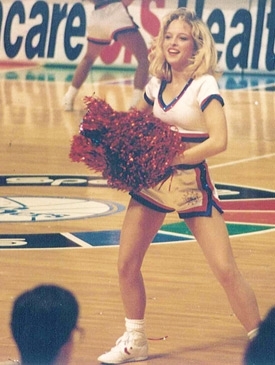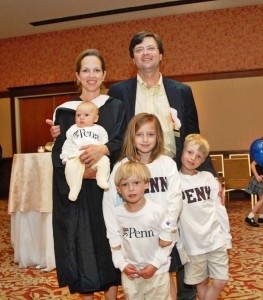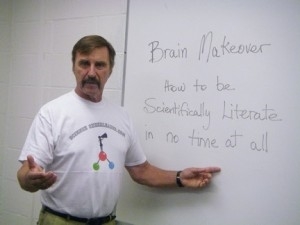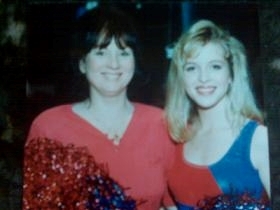 |
| Darlene Cavalier (sciencecheerleader.com) |
Science and cheerleaders. Not two things that people normally put together, but Darlene Cavalier… former Philadelphia 76ers cheerleader and holder of a Master's degree from the University of Philadelphia, believes this combination can help bring science literacy back to the general public. (Science literacy in the American public now sits at just 7%.)
It is also Ms. Cavalier’s mission to help restore the Congressional Office of Technology Assessment, but this time with citizen involvement. OTA’s purpose was to provide Congressional members and committees with objective and authoritative analysis of the complex scientific and technical issues of our times… an office that was copied around the world until it was shuttered in 1995. To this end Darlene Cavalier spends a lot of time lobbying in the halls of congress in Washington, DC, while juggling the active schedule of a married mother of 4 young children.
 |
| Darlene as a Philadelphia 76ers cheerleader (sciencecheerleader.com) |
But how did this all begin? When Darlene Cavalier was getting her first degree in Communications from Temple University and needed some extra money she became a cheerleader for the Philadelphia 76ers basketball team. She shared the court with Sir Charles Barkley and had a great time in the process. At the time, science literacy was far from her mind.
A temp job after college grew from stuffing envelopes in the mail room to working for DISCOVER magazine and their technology awards program. Darlene told me, “My job was to call the nominators and the scientists themselves and I was struck by how normal and nice they were and how I actually understood what they were talking about.” Darlene eventually became the Senior Manager of Global Business Development for Disney Publishing, specializing in development and strategic marketing. In this capacity she worked with some of the brightest minds in science, the media and government to create national science award programs, science education initiatives and science-themed round tables for Disney at EPCOT, Space.com, Sally Ride’s Imaginary Lines and the National Science Foundation. “My 10 years at Discover awoke a long-slumbering love of science and a chance conversation with an editor at Discover propelled me to go back to University to get my master’s.”
 |
| Darlene with her family. (Darlene Cavalier) |
“I returned to school at the University of Pennsylvania and dove into science history, sociology and science policy to learn more about people like me: people with no hard academic background who are deeply interested in science, especially in its public faces in science policy and science literacy.” It was there that she discovered Citizen Science networks. These are people that are passionate about the subjects they get involved with. “Through their grass roots, bottom-up efforts,” Darlene explains, “they aid research in a plethora of science fields by tagging butterflies, monitoring the health of water, keeping an eye on migratory patterns of birds, discovering new galaxies and much more. They can push for the restoration of impartial, citizen-involved science advisory bodies and help shape public policy to make sure government represents the will of its citizens.”
There are many of these groups active today but with the rapid changes going on in the world many more are needed for science to be able to keep up with itself. For example at GalaxyZoo.org, amateur astronomers help sift through hundreds of thousands of images and often see things people with PhD’s might miss because they just don’t have the same amount of time to devote to a single image.
According to Wikipedia, the longest-running citizen science project currently active is probably the Audubon Society's Christmas Bird Count, which started in 1900. Instead of killing birds mindlessly, U.S. ornithologist Frank Chapman, an officer in the recently formed National Audubon Society, proposed counting birds on Christmas instead of killing them. In 1900, 27 observers took part in the first count in 25 places in the United States and Canada, 15 of them in the northeastern U.S. from Massachusetts to Philadelphia. Since then, the counts have been held every winter, usually with increasing numbers of observers. For instance, the 101st count, in the winter of 2000–2001, involved 52,471 people in 1,823 places in 17 countries (but mostly in the U.S. and Canada). It shows how much information can be gathered if the desire to learn and participate is high.
 |
| Physics Professor James Trefil of George Mason U (sciencecheerleader.com) |
Darlene wondered how to bridge this gap between ordinary citizens, scientists and government policymakers. She decided she would need to combine “the academic attitude of UPenn, the mass reach of Disney and the in your face, pom-pom waving personality of a 76ers Cheerleader to kick-start the process.”
In 2008, she founded ScienceCheerleader.com to “get the conversation going, rally the troops, solicit views from all sides and change the tone of science and science policy in this country.” The response has ranged from sniggering in the halls of congress to wide-ranging appreciation from citizen science projects. To make sure people would take Darlene and her cause seriously she enlisted the help of Jim Trefil, Professor of Physics at George Mason University, to create the Brain Makeover and bring general science concepts to the public in a fun, easy to understand way. Go to her site to watch the current 76ers Cheerleaders run through the 18 key concepts in science that will help you be a “scientific literate,” pain-free! (*Concepts adapted from Professor Trefil’s book, Why Science?, Teachers College Press, 11/1/97.)
To see how science literate you are, take the quiz…
If you need to review, check out the 18 key concepts before you test yourself.
1. The universe is regular and predictable.
2. Energy is conserved and always moves from more useful to less useful forms.
3. Electricity and magnetism are two sides of the same coin.
4. All matter is made of atoms.
5. Everything comes in discrete units and you can’t measure anything without changing it.
6. Atoms are bound by electron glue.
7. The way a material behaves depends on how its atoms are arranged.
8. Nuclear energy comes from the conversion of mass.
9. All matter is made from quarks and leptons.
10. Stars live and stars die.
11. The universe was born at a specific time and has been expanding ever since.
12. Every observer sees the same laws of nature.
13. The surface of the Earth is constantly changing.
14. The Earth operates in many cycles.
15. All living things are made from cells, the chemical factories of life.
16. All life is based on the same genetic code.
17. All forms of life evolved by natural selection.
18. All life is connected.
 |
| Darlene and her Mom (Darlene Cavalier) |
Darlene Cavalier’s love for science is probably in her DNA. Her mother, who is also her hero, loved biology and though she was a single mom of four kids, opted to enroll in college to become a nurse. Darlene told me, “She’s my hero because she’s resourceful and unstoppable; she made a quilt from the scraps she was left with and taught me that education was my key to a better future. And she was right.” Darlene’s mom passed on more than her love for science. That resourceful and unstoppable part seems to have made it as well.
Page created on 9/14/2009 11:54:19 AM
Last edited 1/9/2017 9:41:46 PM
